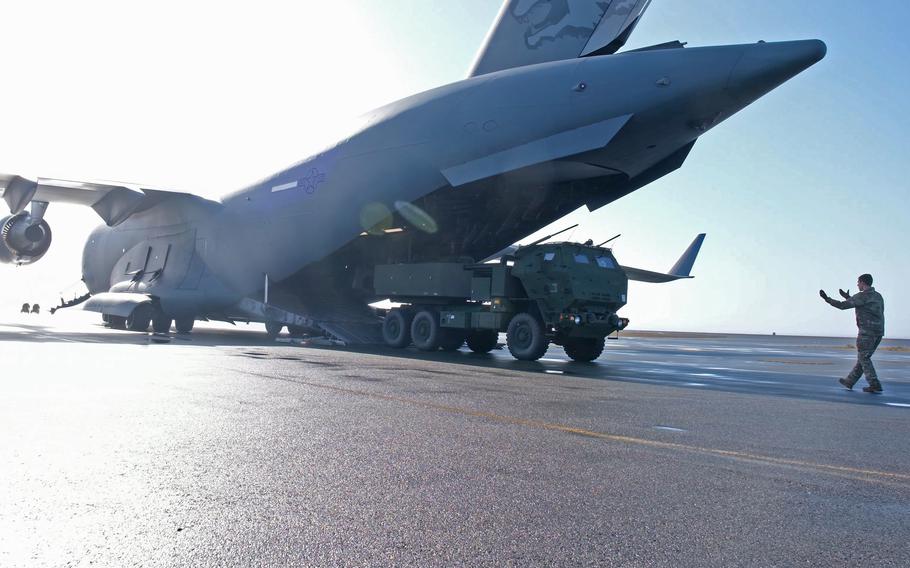
An airman with the Alaska Air National Guard guides a High Mobility Artillery Rocket System, or HIMARS, from the back of a C-17 Globemaster III after landing on Shemya Island, Alaska, on Sept. 12, 2024. (Brandon Vasquez/U.S. Army)
Portions of three Army units have been deployed to Shemya Island off the coast of Alaska in response to recent Russian and Chinese air and sea probes into the Arctic region, service officials said.
Elements of the 11th Airborne Division and the 1st and 3rd Multi Domain Task Forces landed Thursday on Shemya Island, which is part of the Aleutian Islands. The 2.7-mile-wide island is 1,200 miles west of Anchorage in the archipelago of Alaskan islands.
The unit is made up of about 130 soldiers, said John Pennell, a spokesman for the 11th Airborne Division. That is the equivalent of an Army combat infantry company.
Maj. Gen. Joseph Hilbert, commanding general of the 11th Airborne Division, which has its headquarters at Joint Base Elmendorf-Richardson near Anchorage, said the move — along with additional action by the Air Force — was a show of force following recent Russian and Chinese military activity in the Arctic.
“As the number of adversarial exercises increases around Alaska and throughout the region, including June’s joint Russian-Chinese bomber patrol, the operation to Shemya Island demonstrates the division’s ability to respond to events in the Indo-Pacific or across the globe, with a ready, lethal force within hours,” Hilbert said in a statement issued Friday.

Radar located at Eareckson Air Station on Shemya Island, Alaska. (North American Aerospace Defense Command)
The deployed troops included units from Elmendorf-Richardson and Fort Wainwright, the 11th Airborne’s northernmost garrison, Army officials said. The forces include a High Mobility Artillery Rocket System, known as HIMARS, which fires ballistic missiles.
Space Force also operates a long-range radar at Eareckson Air Station on Shemya Island. The radar is primarily designed to pick up and monitor Russian, Chinese and other ICBM missile launches and tests.
The 11th Airborne deployment comes after two Russian IL-38 maritime patrol aircraft were tracked in the Alaska Air Defense Identification Zone on Saturday, according to the North American Aerospace Defense Command.
While the Russian aircraft remained outside of U.S. and Canadian territorial airspace, the planes flew in the Alaska zone where the U.S. expects international aircraft to identify themselves. However, the zone has not been recognized in a formal agreement with Russia.
The surveillance flight is one of several by the Russian military in recent months that skirted international boundaries and drew attention from the U.S. and its allies.
In another related incident, Russian patrol aircraft on Thursday circled Japan for the first time in five years, according to a statement by Japan’s Joint Staff. The Russian Tu-124, which is primarily a transport aircraft, passed Okinawa, where the U.S. maintains military forces.
Japanese fighters were also scrambled Aug. 26 to intercept a Chinese Y-9 surveillance plane that flew into Japanese airspace south of Kyushu, the first such incursion by a Chinese military aircraft.
In July, Moscow sent a pair of missile-armed, long-range Tu-95MS Bear-H aircraft that can be used for reconnaissance, anti-shipping and bombing missions on a 10-hour flight between Japan and South Korea.
Russia and China have been increasingly cooperating in military exercises. The recent Ocean 24 exercise saw the deployment of ships and aircraft simultaneously in the Arctic, Sea of Japan, Mediterranean, Caspian Sea, Baltic Sea and Caspian Sea. The exercise involved 90,000 troops, 400 ships and submarines.
The 11th Airborne statement on the deployment to Shemya Island said Russian and Chinese activity in the Arctic has increased in recent years as climate change has opened sea lanes in the far north.
The Arctic is also considered the northern edge of the Indo-Pacific region, which reaches south toward China and Southeast Asia, and west to the eastern edge of the Indian subcontinent, “an area representing 50% of the world’s population,” according to the 11th Airborne.